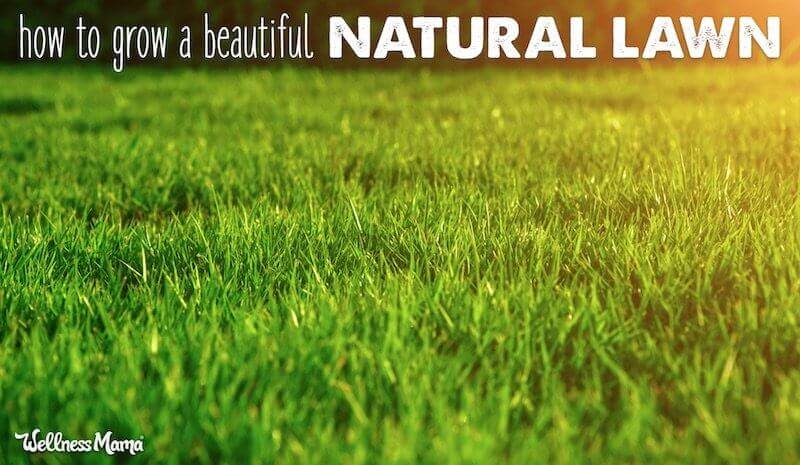Once upon a time, a well-meaning landscaper offered to do some work for our yard. He suggested spraying the yard with glyphosate to “get rid of all the unsightly dandelions and weeds (*ahem* like plantain) to grow a beautiful lawn.
The poor guy didn’t quite understand why I was so adamant that there would never be glyphosate sprayed in our yard under any circumstances. He insisted that “it really is non-toxic and completely safe as soon as it dries.”
I also had to explain to him that we actually like those so-called “weeds” in our yard and that we use them in various ways. Our definition of a “good lawn” was different than his!
Is It Possible to Grow a Beautiful Lawn Naturally?
In many places, an attractive and “good” lawn means one free of weeds with a lush carpet of uniform green grass. In fact, Americans are so obsessed with attractive lawns it is now a multi-billion dollar industry.
We spend money to kill the plants that are already growing and then plant or sod with grass. We replace the natural ground coverings like clover, plantain, and dandelion (which are great for pollinators) with flowerless grass for the sake of looks.
I definitely understand why, and in many neighborhoods with HOAs, these are requirements. The good news is that there are many ways to maintain an attractive lawn without the need for harsh chemicals.
Making this switch can actually help save money. It will also improve growth for pollinators and reduce chemical use and exposure. It will also create a safer lawn for children and pets to play on!
The Problem With Lawn Chemicals
Many people assume that lawn chemicals are completely harmless, but that isn’t the case. Consider this:
Our love affair with lawns comes with a cost. Each year U.S. homeowners apply more than 3 million tons of synthetic lawn fertilizers and 70 million pounds of lawn pesticides and herbicides. These chemicals pose serious hazards to our children, our pets and wildlife of all kinds. To make matters worse, it’s estimated that 65 percent of these chemicals find their way into our lakes, rivers and underground aquifers. (Gardeners.com)
The US Wildlife Federation also reports these environmental effects of our lawn care practices:
- The average lawn gets up to 10x as much chemical pesticide and herbicide use as commercial farmland! This means that the grass your children are running on barefoot probably contains more chemicals than commercially sprayed wheat, corn, and soybean crops. (Obviously, this isn’t great for pets either!)
- When these chemicals are used as much as 90% of the earthworm population in a lawn is killed. This is very detrimental for the soil over time.
- Lawn equipment like mowers and weedeaters (or weedwackers, depending on where you’re from), emit much more waste into the air than cars and trucks.
- 25-60% of residential water usage (depending on location) goes to watering lawns. With droughts in many areas, this is a substantial water burden.
Natural and Organic Lawn Care Basics
Making the switch to natural lawn care may be one of the easies and cheapest switches you can make. It is certainly an easier process than things like improving the water in your home or even overhauling your meals with meal planning (though I recommend those too!).
Starting in the spring, use these basic steps to create a more natural lawn:
Improve the Soil
Many beautiful lawns are really just nice looking on the surface. One problem with irrigation is it affects the quality of the root system. (Fun fact: This podcast explains how irrigation lowers the quality of grapes grown for wine.)
Most lawns are used to being fed and watered from above by irrigation and fertilizer. They don’t have a deep root system and so drought or other problems easily affect them.
When it comes to growing anything, including a lawn, it is good to start from the bottom up. Improving soil first will give your grass a foundation for long-term growth. It will also make the grass more hardy and reduce the need for watering and chemicals.
Soil testing helps you know what is needed for your lawn. Free or inexpensive soil testing is available in many county extension offices or local garden shops. Find one in your area to get a soil test.
If you don’t want to soil test, just use a shovel to remove a 6-inch deep section of soil and grass. Healthy soil should be dark and crumble easily and grass should have a strong root system. An accumulation of dead matter at the base of grass (called thatch) also may indicate poor soil quality. In healthy grass, thatch rarely occurs since the active microorganisms in good soil break it down.
Good soil for grass also has a pH that is slightly acidic and just under 7.
Steps for Better Lawn Soil
- First, aerate in the spring if needed to improve soil texture.
- Then, fertilize once per year with compost. This is called topdressing and is done by adding up to an inch of compost or topsoil and raking into the grass.
- Finally, add pH adjusters if needed to get the pH in optimal range.
Choose Good Grass
Ask a local 4-H office or lawn care expert what grasses are native to the area. Choose one that is hardy and doesn’t need a lot of extra water.
Also consider sun and shade requirements, how much traffic your lawn gets and how much rain your area gets when choosing a grass. The University of Georgia- College of Agricultural and Environmental Sciences suggests these as the max times to wait between waterings for different types of grass:
12 – 21 days: Bahia grass, Buffalo gass, Bermuda grass, St. Augustine grass, Centipede grass
8 – 12 days: Carpet grass, Fine fescue, Kikuyu grass, Seashore paspalum, Tall fescue, Zoysia
5 – 7 days: Ryegrass, Kentucky Bluegrass, Bentgrass
These times are a good measure of a grass that grows well in your area and a helpful metric in selecting a grass.
You may not love to hear this, but growing a single plant (like one type of grass) over a large area is unnatural. This increases the chance of disease and nutrient demand.
Add a crop like white clover to grass to improve the nitrogen content of the soil and keep a thick, lush lawn. If you have the ability, converting part of your lawn to a wildflower growth area for local flowers is a great way to improve soil and make pollinators happy.
Steps for Choosing Good Grass for a Lawn
- First, make sure soil is ready.
- Find out which varieties of grass grow best in your area.
- Choose a grass that matches your yard conditions (shade/sun, etc.) and that won’t require much watering.
- Finally, overseed in the fall. Overseeding is spreading 3-4 pounds of grass seed per 1000 feet of lawn. Cut grass to about 2-2.5 inches before seeding for optimal growth.
Mow the Right Way
Most of us over-mow our yards. Why all that extra work for no good reason?
We think that shorter is better, but it isn’t! It is much better to mow often but not as short. Cutting grass below 2 inches can stress the plant and expose the roots. This also causes over-drying and can deplete soil resources more quickly.
Steps to Mow the Right Way:
- Don’t mow shorter than 3 inches.
- Mow more often and don’t cut more than 1/3 of the leaf off at a time.
- Don’t mow when it is too hot or too dry.
- Keep mower blade sharp and set at the highest setting.
- If you have a small lawn, consider using a reel mower (we like this one) and get some exercise in the process!
Water Carefully
Lawn watering accounts for over half of residential water usage in the summer. Using the steps above will reduce the amount of water needed and create a stronger lawn.
It is also important to water consistently, but not too often. Letting the soil dry out between waterings forces grass to grow deeper roots to find water. When you do water, water deeply.
About an inch a week — and remember, this includes rainfall — should keep a lawn healthy and green.
Steps to Water Grass for a Good Lawn:
- Water less frequently but more deeply.
- Choose grass that is more drought-tolerant.
- Most lawns need about 1 inch per week.
- If it rains more than 1 inch per week, there is no need to water.
Fertilize Naturally
There is really no need for expensive chemical fertilizers. Natural fertilizers like compost work just as well!
Natural solutions also nourish the soil over time, not just feed the grass from the top. This creates a stronger lawn over time.
Top dressing is one way to do this. Scatter 1/2 inch compost or natural fertilizer over the grass and rake in. Alternately, broadcast natural fertilizer after aerating or before watering.
Add the necessary nutrients determined by soil testing. Your lawn will improve dramatically if your grass is in need of certain nutrients or a different pH.
Steps to Fertilize Naturally:
- Broadcast a natural fertilizer in the fall or spring.
- Topdress with 1/2 inch of compost or natural fertilizer and rake into the grass.
- Use a seaweed extract as additional fertilizer.
- Focus on soil quality over time instead of a quick fix.
Stop Weeds Without Harmful Chemicals
This is the hardest part to do naturally, but you can do it!
Did you know that weeds can be an indication that lawn health isn’t optimal? Improve the soil and you will already be a long way toward reducing weed growth. Many herbicides are harmful to humans and animals too! Studies show chemicals in conventional lawn care contribute to thyroid problems and even non-Hodgkin’s lymphoma. Glyphosate is a whole other story, and definitely does not belong on a lawn where kids and pets play.
The organic lawn care solution: leaving grass longer also helps control weed population by leaving a larger surface area for grass to photosynthesize.
Steps to Reduce Weeds Naturally:
- Many weeds are actually herbs with many benefits. Don’t remove them at all!
- Leave grass longer so it will resist weeds naturally.
- Add a second plant to your lawn like white clover to compete with weeds and replenish soil.
- Avoid harmful herbicides and use natural methods instead.
Grow a Garden Instead!
Feel really brave?
Ditch the lawn completely and grow a garden instead!
You can grow vegetables, herbs and fruits in your front yard and make it look beautiful too! Incorporate vegetables and herbs into an existing garden bed for an easy transition.
Or:
Go all out and turn your entire front yard into a flourishing vegetable garden. Urban front-yard vegetable gardens are becoming very popular. They are a great alternative to a mono crop like grass and you get food too!
Plus, gardening is cheaper than therapy, and you get tomatoes!
Many HOAs don’t allow edible gardens in front yards, but you can work edible plants into your landscape. If you have an urban vegetable garden in your front yard, please share how you did it in the comments!
Check out this list of tips for adding edible plants to your yard.
Growing a Beautiful Lawn Naturally: Bottom Line
You can grow a healthy, beautiful lawn without harmful chemicals!
Choose a native grass for your area. Add a complimentary plant like white clover or even wildflowers! Water when needed consistently but not as often. Fertilize naturally and add compost to improve soil.
The environment, your pets, and the bees will thank you!
Do you use organic lawn care? What sustainable methods have you found for growing a beautiful lawn? Tell me about it below!



Leave a Reply